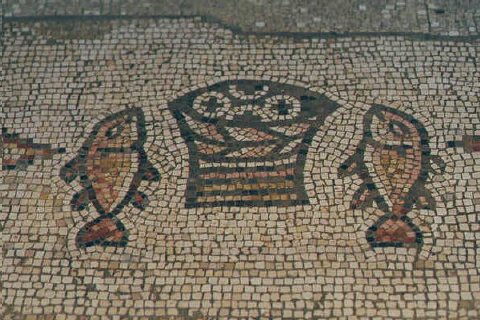

Fish and Loaves - Cana
 This
Byzantine mosaic is preserved under a modern church today, but it was once part
of a church which commemorated Jesus'
feeding of the 5000.
This
Byzantine mosaic is preserved under a modern church today, but it was once part
of a church which commemorated Jesus'
feeding of the 5000.
The Byzantine pilgrims were mistaken in locating this miracle here because Scripture says that it took place in a remote place by Bethsaida. The artist was apparently unacquainted with the fish in the lake as none have two dorsal fins
Cana
Among Christians and other students of the New Testament, Cana is best known as the place where, according to the Fourth Gospel, Jesus performed his first miracle, the turning of a large quantity of water into wine at a wedding feast (John 2:1-11) when the wine provided by the bridegroom had run out. None of the synoptic gospels record this event, but in John's gospel it has considerable symbolic importance: it is the first of the seven miraculous "signs" by which Jesus’ divine status is attested, and around which the gospel is structured.
The story has had considerable importance in the development of Christian pastoral theology, since the facts that Jesus was invited to a wedding, attended and used his divine power to save the celebrations from disaster, are taken as evidence of his approval for marriage and earthly celebrations, in contrast to the more austere views of Saint Paul as found, for example, in 1 Corinthians 7. It has also been used as an argument against Christian teetotalism. A minority of modern readers have asserted that the wedding was originally Jesus' own (some among them identifying the bride as Mary Magdalene), and that an earlier account has been edited in order to suppress this fact.
Holy Land Greece Pilgrimages Pilgrimages Map Index Español English Index